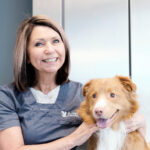BOAS grading
Does your dog suffer from respiratory problems? Or is there perhaps more breathing and panting than is normal? A-Vet now offers BOAS grading based on the Norwegian Kennel Club's screening programme.
Table of contents
What is BOAS Grading?
BOAS grading, or Brachycephalic Obstructive Airway Syndrome grading, is a scale used by veterinarians to assess the severity of airway disease in brachycephalic (short-nosed) dog breeds. Brachycephalic breeds have distinctive short faces and noses. This often creates a narrower and more reduced passage of air through the upper respiratory tract; the result is anything from snorkel noise in the dog to loss of consciousness. In order to be able to breed healthy dogs, an objective assessment is needed of whether the dog suffers from BOAS - and how serious the case is. NKK now offers a separate grading system that aims to confirm and improve the health status of the animals.

The grading scale
The BOAS grading scale ranges between 0 and 3 and is used to assess the severity of airway obstruction in a brachycephalic dog. Here is a brief description of each step on the BOAS grading scale:
- BOAS 0: The dog shows no signs of respiratory problems while resting. The airways are open and normal.
- BOAS 1: Mild degree of airway obstruction. The dog can breathe normally at rest, but may experience problems during physical activity or stress.
- BOAS 2: Moderate degree of airway obstruction. The dog may have breathing problems even at rest, and these symptoms worsen during physical activity.
- BOAS 3: Severe degree of airway obstruction. The dog suffers from severe breathing problems at rest, and the condition worsens dramatically during physical activity. This is the most severe degree of BOAS.
What are symptoms of BOAS?
The disorder has a varying degree of severity. Some dogs will hardly notice it, while others will have a greatly reduced quality of life. Wondering if your dog suffers from BOAS? The following health problems can be symptoms:
- Snoring and wheezing sounds when the dog breathes
- Narrow nostrils
- Vomit
- Breathing problems during sleep; some dogs sleep with their heads elevated, or may stop breathing several times during a sleep period
- Overheating in hot weather
- Impaired exercise ability
- Seizures and loss of consciousness
Grading and treatment
The grading helps vets assess how serious the condition is and what treatment may be needed. Treatment may include surgery to improve the airway, weight management, medication, and lifestyle changes to improve the dog's quality of life and reduce the risk of complications. It is important that owners of brachycephalic dogs work closely with veterinarians to monitor and manage this condition.
Which dog breeds can get a BOAS rating?
The BOAS grading program applies to dogs of the Pug, English bulldog and French bulldog breeds. The dog must be over 18 months. The BOAS certificate is valid for 2 years.
Who can provide BOAS grading?
Not all veterinary clinics can give an approved grading. Only veterinarians who have attended NKK's course in BOAS grading are permitted to write NKK-BOAS certificates, as well as register this in DogWeb.
At A-Vet is a veterinarian Elisabeth Bjørnestad approved to write such a certificate.
Elisabeth is a veterinarian and authorized ophthalmologist with specialization in eye surgery, as well as further training in internal medicine, general surgery, oral surgery and ultrasound from the European School for Advanced Veterinary Studies in Toulouse.
-
Elisabeth Bjørnestadhttps://www.a-vet.no/author/elisabeth_bjornestad/
-
Elisabeth Bjørnestadhttps://www.a-vet.no/author/elisabeth_bjornestad/
-
Elisabeth Bjørnestadhttps://www.a-vet.no/author/elisabeth_bjornestad/
-
Elisabeth Bjørnestadhttps://www.a-vet.no/author/elisabeth_bjornestad/


